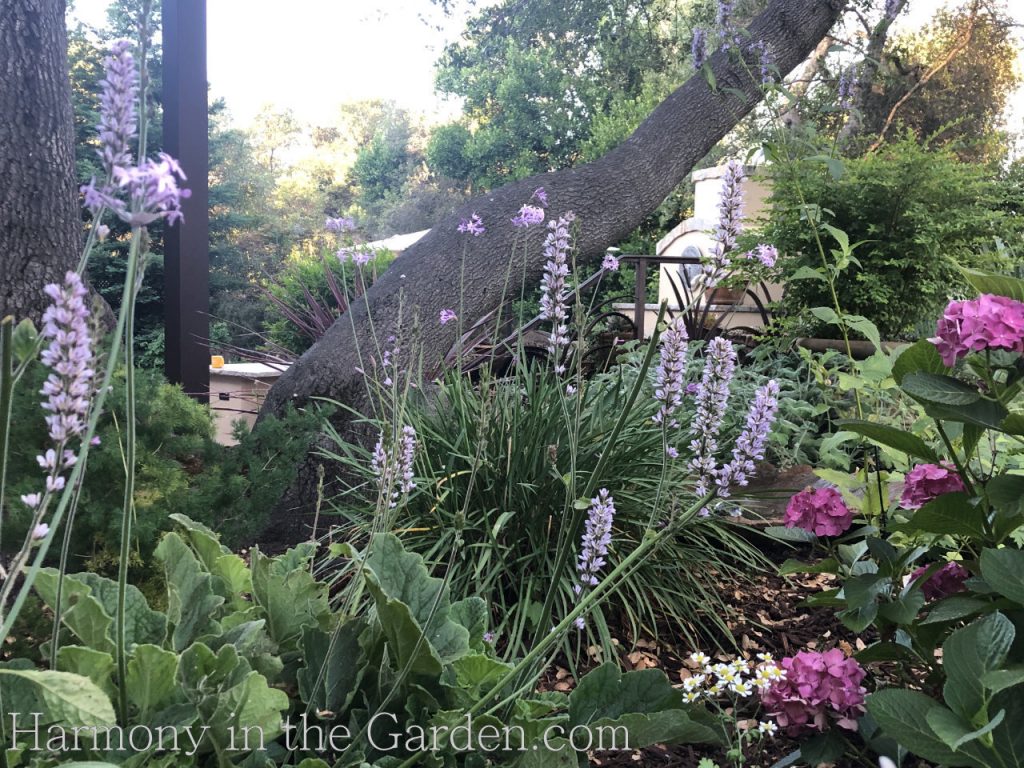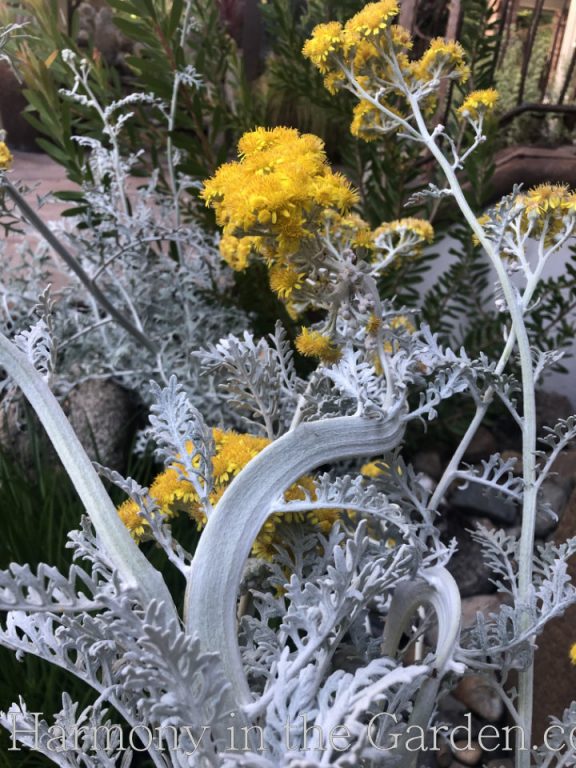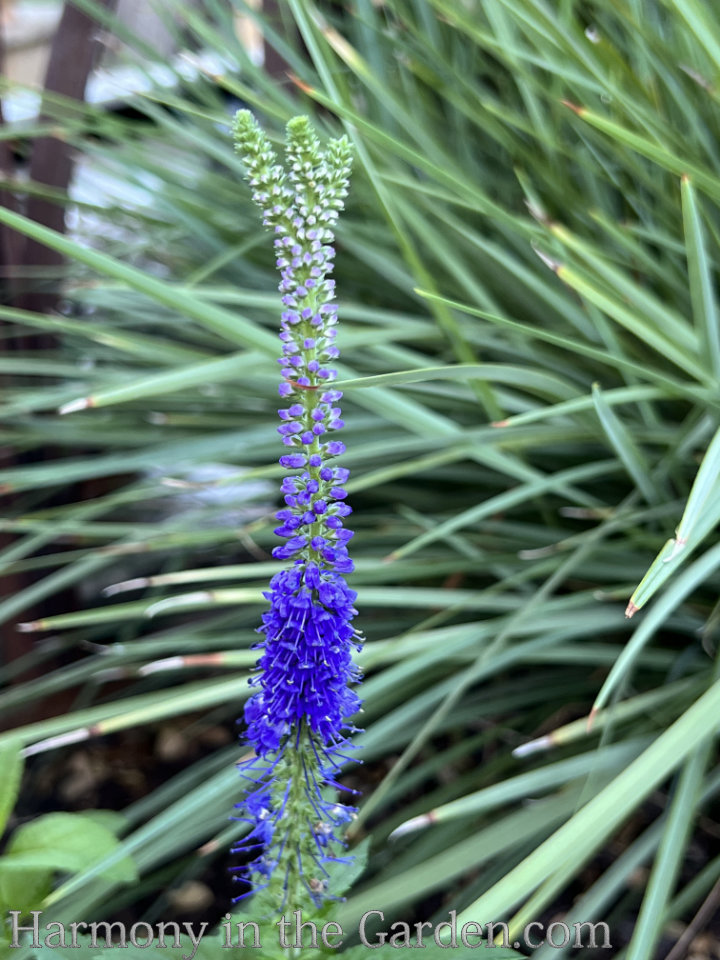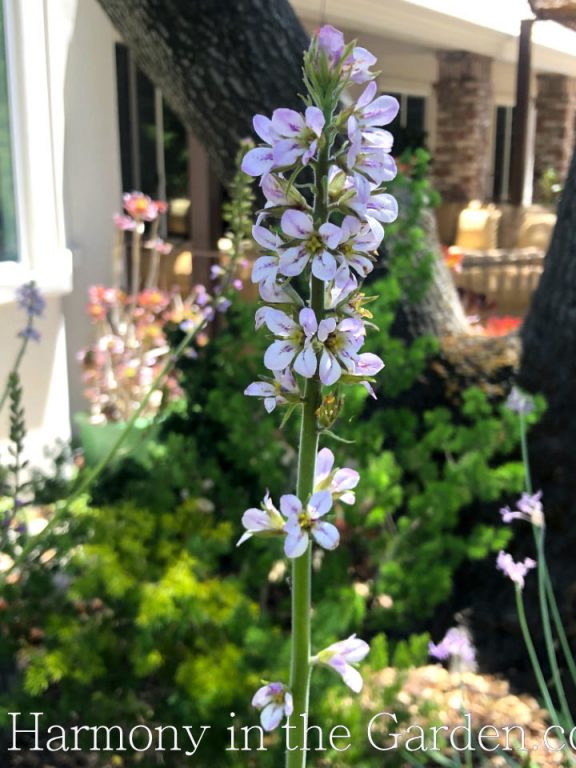
Francoa ramosa is one of my favorite perennials for dry shade. I’ve had them grow equally happy in fairly deep shade to bright shade, requiring little water once established.
In fact, in my zone 9 garden, they’re evergreen, dying back a bit to form a tidy green mound before starting the show all over again in the spring.
They’re hardy down to 20-25 degrees, and even survived a light dusting of snow that we received a few years ago.

The graceful wands of tiny, star-like flowers slowly grow up to 3-feet tall, waving gently in the slightest breeze.
Below the waving flower wands is a 2’x4’ mound of fiddle-shaped foliage with each oversized leaf growing up to 12” long.
Even though it’s not widely known as deer-resistant, I’ve never had deer decimate my plants.
It must be due to the foliage being coarse and slightly sticky. The same goes for snails and slugs – anything sticky tends to send them packing.
Is there a wedding in your future? If so, consider this fun fact: francoa is also known as ‘Bridal Wreath,’ as the long and slender flower stalks were literally used as bridal wreaths – now how cute is that!
Francoa blooms from June through early September, and when picked, the flowers last forever in an arrangement.

One thing I’ve noticed, though, is once every few years francoas can sometimes send out an oddly shaped flower stalk.
While normally pencil-thin, an occasional flower stalk will turn into twisted, funky, flattened flower ‘band’. This is a genetic mutation called ‘fasciation.’
It doesn’t seem to hurt the plant in the least, and in fact, if you were inclined to make a wreath for your head, these flattened bands would work even better!

Fasciation can affect several species of plants, and is due to either a microscopic mite, virus, or even a random genetic mutation.
For example, I’ve seen the same thing happen on my artemisia plant, with the normally thin stem flattening out to a few inches.
And most recently, I’ve noticed a single verbascum flower is splitting off into three little flowers at the very tip!


Francoa is a relatively low-maintenance herbaceous perennial, only requiring the removal of old, damaged foliage and spent flower stalks when necessary.
What’s herbaceous? In a nutshell, it’s a definition given to plants that don’t have woody stalks above ground (ie: all annuals and most perennials.) If interested, The Spruce offers a great definition.
With all it has going for it, I can’t figure out why it’s so hard to find in retail nurseries! Luckily, though, with a little hunting they can be found!
The variety I have is ‘Lavender,’ originally purchased at Annie’s Annuals. Unfortunately, they no longer sell this one, but luckily they have a different one that’s more compact, with larger flowers in a magenta-pink color (you can find it here.)
The most common varieties have light pink (almost white) flowers and can be found at Digging Dog Nursery.
For more plants that thrive in the dry-shade under my oak trees, click here.
And for more plants that do well in dry-shade, I highly recommend this book!
Oh, and if you want to read about yet another funky fungus, click here to see what mites can do to a lemon tree!
For some reason this post is highly ranked on google, one of my top 5! I wonder if that’s due to parents being stuck at home desperate for something new to do with their kids – ha!







29 Comments
Thank you for all the great information and photos. We are experiencing hotter and hotter summers on the west coast of Canada, and many plants that used to grow well in our rainforest climate are now struggling. It was helpful to learn about what survives well in hot dry areas and is less appealing to deer. Thank you so much.
You’re so welcome, Jill. As the temps keep rising I keep trying new varieties and will be updating this post soon with my latest finds. I’m continually surprised by certain plants that I thought would surely burn in the sun and didn’t (and sadly, visa versa!) Stay cool!
I got one of these that I haven’t planted yet but am worried about how it would do over the winter here since it can sometimes stay below 20 for over a week at a time…any chance this would survive in a large pot/planter if I brought it into an enclosed sunporch over the winter?
I would certainly give it a try since it’d be protected somewhat. It really only dips down to about 30 (maybe 29, even) at the lowest in my garden, so I’m not sure if it would survive in the teens, but it’s such a great plant that it’s worth trying in a container, sheltered on your porch. Let me know how it goes!
I have had mine for many years. Zone 8. We have had temperatures in the teens in the PNW. Still going strong and reseeds sometimes.
Thanks for commenting, Linda, and good to know it’ll survive colder temps! I’ve never had any reseed, but I’ll keep an eye out for some in a newly planted patch of them.
Hi,
I just read your blog on Francoa, which I love- will it grow in clay soil? I have an area beneath a tree that’s dry/shady. It’s a problem area because it’s covered with oxalis, which I can’t get rid of- even with a few attempts of covering it with cardboard and mulch. I’ve given up but I would like to claim an area for some blooming plants, including francoa….will daffodils grow ok there for a spring bloom?
Your work is beautiful and thank you for all your generous information.
Hi Pat, I’m so glad you’re enjoying my blog, thank you! Francoa is pretty easy but it does need well-drained soil, which clay doesn’t provide. However, I also have clay soil and mine seems to be just fine once I mixed in succulent/cactus mix before planting (which is really loose and helps aerate the soil) – you might give that a try. I think daffodils want more sun to bloom, but my snowdrops thrive with clay soil in partial shade. I particularly like the ‘gravetye giant’ variety.
Thank you- I’ll give both a try! Do you ever give talks in the east bay- Ca. region?
I occasionally do in-person talks but have been focusing more and more on Zoom presentations. Good luck with the francoa!
Thank you for the article. I have a pot of this that came from a friend several years ago. It’s been thriving in some dry shade. This information was really helpful and now I think I’ll divide it and try it in more areas around my zone 9b garden. Thanks!
You’re welcome, ruth, and lucky you to have some – they’ve become so hard to find now. I’ve divided mine around my garden, as well as given a bit away to friends. It seems to root pretty easily. Good luck! 🙂
Thanks for this article on Francoa. I garden in Canberra Australia where we have hot summers and some frost in winter down to about -3 or so.
I bought my Francia online from the wonderful Lambley nursery near Melbourne . Dry shade was the clincher for me as I have an area under a large maple tree that I’m gradually filling with interesting things . The Francoa sulked for 2 seasons … not spreading or flowering and showing very pale leaves suggesting it was lacking iron or some other element ! I started giving it some chelates and it improved but still has very pale and veined new leaves …. But it has flowered at last ( very cool and damp spring and summer so far here – wettest since records kept ! ) The flower stems are falling over more than I’d like but I’m just happy to see it doing better. Any thoughts for helping it more ? It’s rarely seen in local nurseries so I’m keen to nurture it ! Thanks again for your fascinating blog . Judith
Hello Judith, and so nice to hear from you all the way from Australia! Mine is absolutely thriving with very little water and part shade, but I wonder if it’s also because it’s planted under my nyger seed bird feeder? There’s lots of seed hulls (those are the black, tiny seeds – sometimes called millet here) at the base and maybe they’re helping to add nutrients to the soil? I had francoa in my other garden, in much more shade, and it seemed happy as well (without any seed hulls) but in both gardens I heavily mulch with shredded bark/bark chips – perhaps that helps as well? I wish I had an answer for you – let me know if you crack the code on this wonderful plant!
I have the dry shade but live in Zone 6 and we get down to -10 degrees. Thanks for sharing a very pretty flower.
Rats – I wish they would thrive there, Frieda but you’re right about the -10 degrees not being ideal for them. 🙁
A friend let me take a divide of hers and it’s just now showing signs of the flower stem coming up. So excited to see what it looks like. I live in Mendocino County, close to the coast and I have a hard time finding plants that will withstand the wind and fog. The francoa seems to do really well here. I have lots of deer and they do munch off one or two of the blooms but they don’t seem to bother them too much. I see you mentioned Digging Dog nursery; one of my favorite places. I’m not sure they are open, but I know they are busy with mail orders. I look forward to all your posts.
Linda Dunbaugh
I’m so glad to hear they do well for you, and I’ll hope the flower on your new plant is the lavender color like mine. It’s so pretty and impossible to find any longer. I’ve never actually been to Digging Dog, but it’s on my bucket list of nurseries to visit. I am, however, very familiar with their mail order department – ha! Thank heavens for that as some of my favorite plants come from them. Thanks for commenting!
Once Digging Dog is open again, you must come and see it. She usually does tours and shows off her gardens around her property but not sure that will happen this year. Then you can also see the Mendocino Botanical Garden on the same trip. I volunteer a the Botanical Garden and it’s my happy place.
I’ll definitely plan a trip, Linda – sounds heavenly! And whenever I can coordinate it (maybe next sprin?) I’ll be sure and let you know and perhaps we could have a cup of tea in the Botanical Garden’s cafe!
Please do. I’ve been following you for years and it would be great to meet you in person. Maybe you’d be willing to come to a Ft Bragg garden club meeting. We meet at the Botanical Garden. Obviously, we aren’t having meetings right now but hopefully this spring. Take care.
Linda Dunbaugh
Thank you indeed for the update on Francoa. It does well in my Seattle garden but has not spread. I have it in full sun and normal watering so I might be better moving it to dry shade. It totally disappears over the winter -aha another reason why the plant never gets bigger. It is worth the wait though. Fasciation occurs in lots of plants but is quite rare. and does no harm to the plant although I found that I don’t like the look and cut it off after the fascination with this rare
phenominum fades. Thank you for your lovely posts.
Hi Joan, just after writing this my mother said she found her candytuft has some fasciation on it, too. I’m not a huge fan of it either and am so glad it doesn’t hurt the plant. Glad to hear it’s cold hardy in Seattle, but sorry it hasn’t gotten bigger for you. Thanks for the kind words. 🙂
Perfect timing. I have a shady area close (but no too close) to an oak that I want to plant and this plant sounds perfect. I’d love more suggestions for what works well near oaks.
Hi Courtney, I’ve also had really great luck with our native heuchera maxima (it’s a large one and quite stunning – I often plant it under oaks) as well as aeoniums (if you like tall succulents), or foxtail fern (Asparagus aethiopicus) and my favorite groundcover geranium ‘biokovo’. Hope you have some luck with these!
It really is strange that Francoa is so unknown to gardeners. I must admit that I only learned about them a few years ago. There are lovely, large patches of white-flowered Francoa growing in the Woodland Garden and around the ancient fountain at Filoli and they are much admired when in bloom.
I have gardening friends that grow them but I don’t see them in nurseries either. This is a plant that needs marketing! ! ?
I’d love to see them at Filoli (actually, I’d love to see anything at Filoli!!) and bet they’re stunning next to the fountain. They’re such an old fashioned plant and as I recall an older Sunset Western Garden Book says they’re most often passed from neighbor to neighbor vs. found in nurseries. Isn’t that the truth! It definitely needs a new marketing team, that’s for sure!
Wow, thanks for highlighting francoa, one of the most reliable plants in my Los Altos garden! I have potted it up for our Garden Club sale but there’s not a lot of interest in them, since most people don’t know what they are. I do enjoy all your articles and especially enjoy them now that we’re stuck at home most of the time. What I didn’t realize is they do well without a lot of water when established. Thanks for that tip, and maybe I will try them in new places!
Lucky you, Nancy, to have so many that you can take cuttings! Maybe post a sign next to them touting their beautiful flowers & dry shade (like Annie’s Annuals does) and I bet they’d sell out super fast! I so enjoy taking photos and sharing my love of plants with others and it’s always glad to hear when someone enjoys them – thank you!